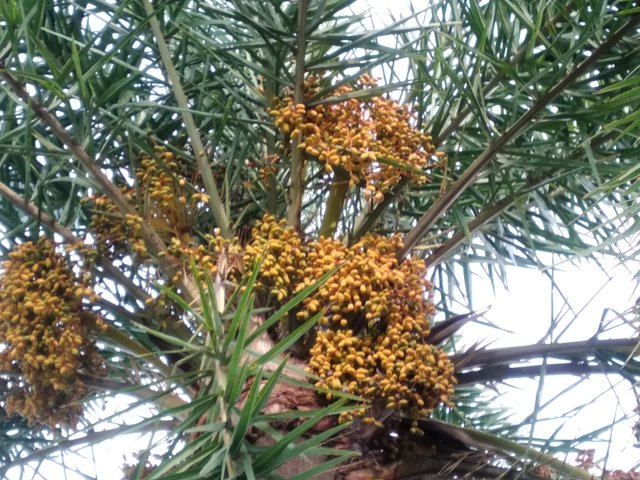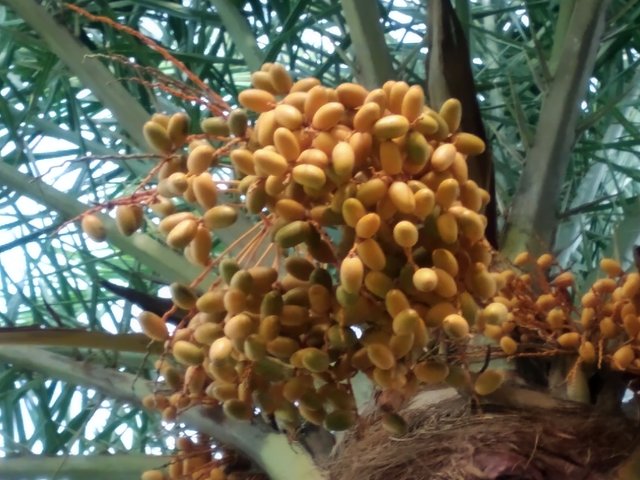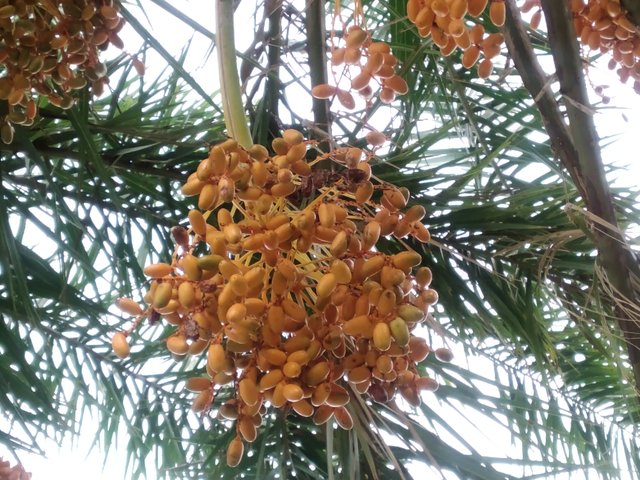



Some people call native dates wild or wild dates. Because no one cultivates it, the trees of the forest. This is why it may have been given the English name Wild Date Palm. Native dates are one of the oldest fruits in the country. Origin in this country, spread in this country. The Latin word Sylvestris for botanical name means wild. The tree grows mainly in the forests of this country. Palm trees are usually planted on fallow land, on the banks of dams, on the banks of ponds, on land isles, around houses and gardens, on both sides of the road. But it is not for fruit, it is for juice. Gurpatali is made from the sweet juice of the tree. In this country, dates are considered as a molasses producing crop. The taste of Nalen molasses is tempting to everyone in winter days. Since dates are not widely cultivated like other crops, they are grown in homes, fields, roadsides. So it is difficult to calculate exactly how much land is being planted with dates. In the last 2016-17, the total production of date juice in this country was 169058 tons. It has been estimated that it was extracted from a total of 5132 acres of date palm trees. In the same year, the production of domestic dates was 37939 tons (BBS 2017). Rajshahi, Natore and Jessore have the most date palms. The Department of Agricultural Extension has already taken a special program to expand the cultivation of native dates.
Botanical description
The date palms belong to the Phoenix genus of the Ericaceae family. There are 14 species of phoenix trees in the world. Of these, two species are important as crops. Phoenix sylvestris (L.) Roxb. Involved. Species of native or wild dates and Phoenix dactylifera L. b. The species is known as Arabic date palm or Saudi date palm. The first species yields sap and the second species produces succulent fruit. The date palm is a monocotyledonous, single sex tree. That means male and female trees are different. The girl bears fruit on the tree. Branchless trees are about 4-15 m tall. The bark-like covering of the tree covers all the stems of the petiole. The native date palm is a fast-growing, branchless tree with a single stem. The roots of native date palms have thick and pile-like roots. Even after the leaves fall off the stem, the base part of the leaf shell sticks to the stem which gives extra beauty to the date palm. The leaves are winged, on either side of the stem, the apex pointed, with sharp hard spines at the base. The leaves on the top of the tree grow like a coconut-betel tree. Flowers bloom in the month of Chaitra. Male and female flowers bloom in tears. Male flowers are small white. The fruit is in summer. The fruits are ovate, yellow in color, about 2.5 cm in length. Inside is a light brown seed. The seeds have a thin shell-like shell on top. Raw shell kaisatya-salt. But when ripe, it is quite sweet. The color of ripe dates is from reddish brown to brown. Ripe dates are very popular among the children of Bengal. Dates are propagated by seeds.
Origin and spread
Indigenous date palms extend from East Asia, especially from the west of the Himalayas to India to Nepal and Myanmar.
Palm trees are scattered almost everywhere in the country. Even in the Sundarbans and coastal areas, date palms have been seen. However, more and better date palms are grown in Jessore, Natore, Rajshahi and Faridpur districts.
Use
Indigenous dates are considered as a crop producing sugar or molasses. The main use of date palm is to produce juice and molasses. However, the fruit can be eaten. Many people do not eat native date fruits as they are of very low quality. The shell of the native date fruit is thin, the beech is large, the storage capacity of the ripe fruit is very low. Yet the luscious smell and sweet taste of ripe fruit attracts many. Especially children and adolescents. Distilled wine or beer can be made from date juice. This locally made wine is called 'Tari'. In a special way, the sap is squeezed towards the head of the tree. The juice is extracted by cutting the dot of the inflorescence that is not blooming anywhere. The average juice production is 5 liters per plant. When the health of the plant is good, the amount of sap is more available. Juice is available from date palms in winter. Drinking fresh date juice on winter mornings is a tradition of rural Bengal. Before cutting the date palm, the leaves are pruned. The blades of these leaves are dried in the sun to make patterned palms and handbags or some other handicrafts. Pati, mats, baskets etc. are made from date leaves in rural Bengal. Many people in the village use date palms as building materials. Its trunk is used to build bridges over small ditches or canals. In some places date palms are planted in the garden as ornamental trees. Dates are good for heart disease, fever and stomach ailments. Fruit tonic. The result is a lot of iron ore.
Weather and soil
Indigenous date palms can grow anywhere from dry to humid. The birth and growth of native date palms is better where the day temperature is 25-35 degrees centigrade. However, even if the temperature drops, the date palm can survive. Young trees are severely damaged by temperatures near freezing. Annual rainfall of 400-600 mm is required for date palms. I want a sunny place for date palms. Dates can grow in different types of soils. However, the soil must be well drained. Otherwise the tree will not survive. It is better if the soil acidity or pH is 5.5-6.5. Date trees are good in saline soils.
Seedlings made
Indigenous date seedlings can be made from seeds. If well-ripe fruits are picked from the tree and left for a few days, the fruits become more ripe and the peel and shell become soft and rot. Then the fruits are quickly washed in water to get beech. They can be made into polybags or seedlings. Seedlings can be made at the end of summer. It may take 2-3 months for the seeds to germinate.
Planting seedlings
Most date palms in Bangladesh are planted along roadsides or in grasslands. Not too many dates are cultivated commercially or in garden form. Mainly date palms grow naturally in this country. However, some trees are planted sporadically. Naturally, these trees are not taken care of or very little care is taken. Birds are the main spreaders of native date palms. By eating the fruit, the seeds of those fruits are spread by the birds in distant places by dropping the feces. Squirrels are also spread. From these seeds scattered during the rainy season, date seedlings grow naturally. Farmers in Bangladesh do not usually produce saplings. They pick up naturally born date seedlings and plant them. They usually pick up 15-40 cm long 1-2 year old seedlings and plant them in gardens, backyards, fallow lands or along roadsides. Recently, date cultivation is being expanded in some areas by producing saplings in nurseries, especially in Chittagong region.
For planting date seedlings, the hole should be filled beforehand by mixing the fertilizer with the soil of the hole. It has been observed that if organic and chemical fertilizers are applied in the pits at the time of planting, more sap is obtained from those plants later. Dig a hole of 50-65 cm size in all directions and mix 5-6 kg dung manure, 500 g TSP and 300 g MOP fertilizer with the soil of each hole. One week after filling the hole with fertilizer soil, seedlings should be planted in the middle of the hole. If you want to plant saplings in the aisle of the land, you have to understand the width of the aisle and make a hole and plant the saplings with organic manure. Farmers plant seedlings densely in the garden. However, it is better to give a distance of 4-5 meters from the tree. Seedlings should be planted in rows.
Weed and fertilizer management
Lots of weeds grow in date palms. Especially wool grass. If these weeds are not cleaned, the growth and yield of the tree will be reduced. For this purpose, 1 month after planting the seedlings, weeds should be cleared from the roots of the seedlings and the soil should be chopped and urea fertilizer should be given at the rate of 150-200 grams per plant. Fertilizing after the rains increases the productivity of those trees. Once the seedlings are established, the amount of urea, TSP and MOP fertilizers should be increased from next year in line with the age of the plant. Talking to farmers in the village, it was learned that only a quarter of the farmers dig only a short distance from the base of the tree once a year and apply urea fertilizer. Their experience is that urea fertilizer increases the production of juice in those trees.
Pest management
Indigenous date palms can withstand a lot of stress. Usually this tree is not attacked by pests. However, sometimes some insects and diseases attack the tree, which causes damage to the tree. Especially palm leaves are attacked by scaly insects. Both white and red shell insects or scale insects attack. Young date palms are most affected by white scale insects (Parlatoria blanchardii). Especially when the tree is attacked by white shell insects between the ages of 2-6 years, the tree is severely damaged. Insects like hard white discs or shells colonize many of the leaves together and suck the sap from the leaves to fade, weaken and eventually kill the leaves. Both adult and young shellfish suck sap from the leaves. In severe attacks, the leaves turn yellow and turn brown. They attack on both sides of the leaf, but more on the lower back. Red scab insects (Phoenicococcus marlatti) do the same damage. The color of this insect is dark pink or red. Rhinoceros beetles (Oryctes rhinoceros) can also damage date palms. These hard-bodied insects have shiny black rhino horn-like trunks. The adult rhinoceros beetle destroys the young leaves of date palms. Occasionally, insects attack date palms. Approved pesticides should be sprayed to control these insects. Among the diseases, root rot, yellow mosaic, worm disease, lithal yellowing or yellow die, brittle leaf etc. are important. In case of fungal diseases, the disease can be controlled by spraying Bordeaux mixture or fungicide.
Extracting juice and making molasses
Date juice is one of the unique winter traditions of Abahman Bengal. Desert Arabia is as famous with dates as Bangladesh is with date juice. There are more or less date palms in almost all parts of this country. However, Jessore is known for its palm trees. It is said in the words 'Jessore's glory, date juice'. In other words, Jessore is famous for its date palm and date juice. Even when the Jessore district is symbolically represented somewhere, the picture of the date palm tree there represents Jessore.
Usually the sap of date palm starts from the age of four years when the tree has 12-15 leaves. The juice is extracted from the date palm in a special way. Those who are engaged in the profession of cutting down palm trees and extracting this juice are called ‘trees’. As soon as the winter season starts, the trees in the villages first cut the leaves and bark of the date palm tree and leave it for a few days. He then scratches the bark of the tree with the help of a special kind of sharp knife from one side of the tree head. This is called 'give the tree'. However, ‘cut’ is used to cut the leaves. A small stick is tied horizontally to a tree and the trees stand on their feet, it is called 'Patui Kathi'.
The tree holds a special rope made of palm leaves around his waist with the help of a rope. He is called 'Thungi'. There are these dawas inside the thungi. Hanging with the rope is a clay ‘thila’ like a pitcher. After scratching the bark, the juice starts to come down. Then a shallow groove was cut under the scratched area on both sides and a pencil-like twig was buried in the middle of it. The juice is tied under the stick. The juice extracted in one day is collected from this bag. Trees are usually cut three days a week. The juice that is taken out at the beginning of the week with a break is the best quality juice. It is called ‘Jiran Katter Ras’, the second day Ras is called ‘Do Kater Ras’, the third day Ras is called ‘Jhara Ras’. Good quality molasses and patali are made from the first juice. Toyak molasses and jhola molasses are made from the juice. Molasses is made by thickening the juice in the oven. When the molasses thickened with firewood is poured into a pot and cooled, it becomes patali. Molasses also has different names according to the size of the pot. If molasses is as hard as a flat leaf, it is called Patali. If molasses is collected and hardened by pouring it in small earthenware earthenware pots, it is called Muchi Patali. If you put soft molasses in a pot or earthen jar, it is called Thila molasses. Good quality molasses is made from geranium juice.
Fruit collection and yield
Usually, the fruit of the native date palm falls off the tree and is not collected. Not all fruits ripen together. It ripens for a few days. Summer when the fruit ripens. Birds eat ripe fruits. Fruits fall to the ground and seedlings are formed naturally there. When the color of the fruit to be eaten is green to yellow, it is collected along with the weeds. If left at home, the ripe fruits start ripening in 2-3 days. When ripe, the flesh of the fruit becomes soft and turns reddish maroon. 10-25 kg of fruit is obtained from a tree, 5-6 liters of juice is available.